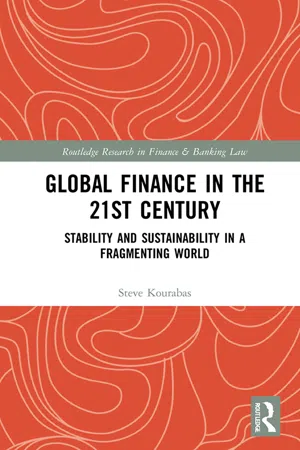Economics
Functions of Financial Markets
Financial markets serve several functions in the economy, including facilitating the allocation of capital, providing liquidity for financial assets, and enabling price discovery. They also allow for risk management through the trading of financial instruments and contribute to the efficient operation of the economy by channeling funds from savers to borrowers.
Written by Perlego with AI-assistance
Related key terms
8 Key excerpts on "Functions of Financial Markets"
- eBook - ePub
Non-Knowledge Risk and Bank-Company Management
The Role of Intangibles in Rating Models
- Vincenzo Formisano(Author)
- 2016(Publication Date)
- Palgrave Macmillan(Publisher)
In an economic system, demand and supply of capital must tend to equilibrium and the capital investment has to be efficient in the sense that the marginal productivity of the different uses should be unvarying. Financial markets play a crucial economic role in making these two results achievable; the maximization of the aggregate return rate of productive capital and, ultimately, the performance of the entire economy, depend on them.This is an economic function of the financial markets understood in a broad sense, that is, related to all types of tools, including credit ones. More detailed consideration can be made, then, with regard to security markets.With regards to the functions of security markets, there are aspects that qualify the activities of security markets that are strictly linked to the nature of negotiated tools and to the characteristics of the organizational form of the market.These functions are:• Financing: the issuance and placement of securities in the primary market (stocks, bonds) correspond to a supply of funds to the issuer.• Pricing: of the negotiable securities and, implicitly, of the expected yield assessment for each security. As long as the yield expected by the investor represents the cost of capital for the issuer, there follows a direct effect on the demand for funds and thus an influence on the allocation process.• Liquidity of securities: negotiable securities give rise to the secondary market, that is, an exchange system powered by the choices of investment/disinvestment of the participants. An efficient secondary market makes securities liquid regardless of their contract term; the liquidity perceived by investors is equivalent to a lower risk implying a rate of return/lower balance cost (it improves the financing of investments).• Reduction of transaction costs - eBook - ePub
Understanding Investments
Theories and Strategies
- Nikiforos T. Laopodis(Author)
- 2020(Publication Date)
- Routledge(Publisher)
Why is channeling of funds from savers to spenders so important to the economy? The simple and short answer is that the people who save are frequently not the same people who have profitable investment opportunities available to them, the entrepreneurs. Suppose that Mr. Haris has saved $1,000 this year, but no borrowing or lending is possible because no financial markets are available. If he does not have an investment opportunity that will permit him to earn income with his savings, Mr. Haris will just hold on to the $1,000 and it will earn no interest. Another person, Nick, however, might have an investment opportunity or idea that he wishes to try and thus needs the money. Hence, in the absence of financial markets, Haris and Nick might never get together. Both would be stuck with the status quo and be worse off, because without financial markets it is hard to transfer funds from a person who has no investment opportunities to one who has them. Therefore financial markets are essential to promoting economic efficiency.Financial markets are critical for producing an efficient allocation of capital (wealth, either financial or physical), which contributes to higher production and efficiency for the overall economy. Indeed, when financial markets break down during financial crises, as they did during the 2008 global financial crisis, severe economic hardship results, which can sometimes lead to dangerous political instability (as in some southern European countries in the early 2010s).4.2.2 Pricing function
This function involves the ability of the financial markets to disseminate pricing information to investors for valuation and trading purposes on a continuous basis. Stated differently, millions of investors routinely collect and process information on various financial assets before making a decision. This information (such as prices of assets, interest rates, the economic conditions of the national and global economy, to name but a few) comes from the financial markets. For example, if you are interested in finding out the current (market) price of IBM’s stock, all you have to do is open up a newspaper or browse on the internet for an instant quote. Similarly, if you are considering purchasing a new house, you will certainly need to know the current mortgage rate. You can find that out by simply going to your local bank or do some comparison shopping on the internet.In addition to pricing information, the transmission of fair prices - S?awomir Ireneusz Bukowski(Author)
- 2019(Publication Date)
- Routledge(Publisher)
In Poland, the bank-oriented system features the following: lower GDP per capita than in the higher-developed countries, relatively lower effectiveness of the legal system than in developed countries, relatively higher corruption and a medium European tendency to risk-taking – greatly differing from American and British standards (see Bukowski, 2011, p. 14).The financial market is one of the key markets in economy, connected with the market of products and services and labor markets through the supply-and-demand coupling and prices. On the one hand, financial markets are platforms where short-, medium- and long-term financial transactions take place and, on the other, mechanisms of short- and long-term capital mobilization and its allocation in order to finance investment ventures operate.Financial instruments embodying capital are traded in financial markets. A financial instrument is a contract (agreement) between two parties that governs financial interdependence between them.A financial market has its infrastructure created by a network of relationships among banks, investment fund companies, insurance societies and stock exchanges. The financial market participants include financial institutions, enterprises, households and the state. These entities provide financial capital and benefit from it at a specific price: interest.Financial markets fulfill an important role in economy. First, they provide a mechanism of capital mobilization for investment purposes, its allocation and its transfer of financial capital into production capital. Second, they determine the price of capital and enable estimations of investment risk, which is the basis of investment decision-making. Third, they strengthen the motivating role of profit in enterprises and enable the enterprise value assessment. Fourth, they assure liquidity in economy, which means that all of the needs of economic entities in terms of money are satisfied. Moreover, financial markets play an important role in the absorption of economic shock results.The financial market institutions include the legal system regulating capital turnovers, institutions of state financial supervision, financial intermediaries and financial instrument exchange markets. The system of law governing capital turnover consists of the rules of public and non-public capital turnover (financial instruments) and “rules of the game” between the turnover participants. It aims at ensuring safety to capital turnover, including the safety of financial investment projects. The distinction between a public and a non-public turnover of financial instruments is conventional. Usually, the criterion here is the number of people to whom the offer for sale of financial instruments is addressed. Public trading of financial instruments is usually subject to special supervision from the state institutions established for this purpose and to special requirements that must be met by the issuers of these instruments concerning the way of presenting economic information, financial safeguards, the way of issuance and so on.- eBook - ePub
Other People's Money
Masters of the Universe or Servants of the People?
- John Kay(Author)
- 2015(Publication Date)
- Profile Books(Publisher)
PART IITHE FUNCTIONS OF FINANCEPart I described what the modern financial system does, how that has been affected by financialisation, and the consequences for the non-financial economy. Part II is concerned with the necessary underlying functions of a modern financial system. Economies need finance to facilitate payments, to channel the savings of individuals into fresh investment, and to enable households to manage their finances over their lifetimes and to transfer wealth between generations. These next chapters describe how, and how well, these core purposes of search for new opportunities and stewardship of existing ones are achieved. Chapter 5 reviews the central mechanism of a capitalist economy – the translation of household wealth into productive assets. Chapters 6 and 7 look at the two primary mechanisms that facilitate that process – the deposit channel and the investment channel.Passage contains an image
5Capital allocationPhysical assetsThe price or money-form of commodities is, like their form of value generally, a form quite distinct from their palpable bodily form.Karl Marx, Capital, 1867, Volume 1, Chapter 3In an ill-judged interview with the Sunday Times in 2009, Lloyd Blankfein, CEO of Goldman Sachs, claimed that his company was doing ‘God’s work’.1 The Deity’s purpose was ‘to help companies to grow by helping them to raise capital. Companies that grow create cash. This, in turn, allows people to have jobs that create more growth and more wealth. It’s a virtuous cycle.’ If you asked the occupants of the executive floors of the buildings on Wall Street or in the City of London to explain what the finance industry contributed to the real economy, their answers would echo Mr Blankfein’s (although perhaps without the divine blessing). The financial sector raises and allocates capital.A central function of financial markets is to direct money from savers to businesses, home-owners and governments. They in turn use these savings to build, own and operate houses, shops, offices, warehouses and factories, to buy plant and machinery, and to develop the nation’s infrastructure and civil works, its roads, bridges, electricity and telephone cables, pipelines and sewers. Or so it should be. - eBook - ePub
Global Finance in the 21st Century
Stability and Sustainability in a Fragmenting World
- Steve Kourabas(Author)
- 2021(Publication Date)
- Routledge(Publisher)
Merton, ‘Financial Innovation and Economic Performance’ (1992) 4(4) Journal of Applied Corporate Finance 12 (noting that the primary function of a financial system is to facilitate the allocation and deployment of economic resources, both spatially and across time, in an uncertain environment). While modern accounts of finance recognise the expansion of finance beyond banks to include other actors and activities, the role of banks remains unique and indispensable to society as banks are still the only institutions that are required to return deposits on demand. There has been an ongoing debate regarding whether bank-based or market-based financial systems are better at allocating funds to productive resources. This debate is beyond the scope of this book, but for a summary of some of the key issues see e.g., Ross Levine, ‘Bank-Based or Market-Based Financial Systems: Which is Better?’ (2002) 11(4) Journal of Financial Intermediation 398. Commentators such as Levine have found that the main issue is not whether a system relies more heavily on banks or financial markets, but instead, whether an environment is created in which intermediaries and markets provide sound financial services. 32 Peter J. Stemp, ‘An Introduction to the Economics of Financial Markets’ (1994) 27(4) The Australian Economic Review 123, 127. 33 Commercial and investment banking services are often provided by the same institution. See e.g., Lawrence G Baxter, ‘Betting Big: Value, Caution and Accountability in an Era of Large Banks and Complex Finance’ (2011–2012) 31 Review of Banking & Financial Law 765, 782. Universal banks are financial institutions that provide a diverse range of financial services to their clients (retail, governmental, corporate or institutional), and operate on a very large scale - eBook - ePub
- Rogerio Studart(Author)
- 1995(Publication Date)
- Routledge(Publisher)
The entrepreneur when he decides to invest has to be satisfied on two points: firstly, that he can obtain sufficient short-term finance during the period of producing the investment; and secondly, that he can eventually fund his short-term obligations by a long-term issue on satisfactory conditions. Occasionally he may be in a position to use his own resources or to make his long-term issue at once; but this makes no difference to the amount of ‘finance’ which has to be found by the market as a whole, but only to the channel through which it reaches the entrepreneur and to the probability that some part of it may be found by the release of cash on the part of himself or the rest of the public. Thus it is convenient to regard the twofold process as the characteristic one.(Keynes 1937c:217)Being the loci where funding takes place, financial markets have an important role in supporting growth. From a microeconomic perspective, they may increase the predisposition of firms and banks to engage in the financing of long-lived assets. Another interrelated microeconomic function is the provision of information for firms issuing securities, underwriters and demanders of securities. This informational role can be summarised as follows: (1) secondary markets signal the price of new issues of securities; (2) secondary markets make underwriting by specialised financial institutions a less risky business;10 and (3) secondary markets enable investors to evaluate the prospective profitability of newly issued securities by enhancing the flow of information (Bain 1981:61).From a macroeconomic viewpoint, funding and, therefore, financial markets also bear a role which is seldom spelled out. That is, the role of mitigating the increasing financial fragility inherent in a growing monetary economy. This macroeconomic role will very much depend upon two interrelated characteristics of the financial markets: their size and their stability. A thin financial market is unlikely to be able to increase its levels of operation without significant shifts of asset prices; and a volatile financial market can provoke sudden shifts of the rate of interest and, therefore, be more damaging than supportive of the process of growth.Finally, it is worth remembering that not only are thin markets highly speculative and volatile, but also speculation a short-term phenomenon which tends to disappear in the long run. Much to the contrary, the very existence of the secondary markets (where old securities are sold and bought) relies on continuous trading, which provides the liquidity that makes it less risky for wealth-owners to hold long-term securities. It is this provision of liquidity which makes long-term bonds and securities attractive to savers—who, as Davidson has rightly put it, are searching for safe liquidity time-machines, and rarely wish to be locked in to holding an asset for a long period of time. - eBook - ePub
Management Economics: An Accelerated Approach
An Accelerated Approach
- William G. Forgang, Karl W. Einolf(Authors)
- 2015(Publication Date)
- Routledge(Publisher)
3Money and the Financial Markets
The previous chapter develops a model of the economy that explains short-term macroeconomic fluctuations through an income and expenditures approach. The prior chapter does not consider (1) the role of money in facilitating transactions in the goods or resource markets, (2) interest rates, monetary policy, and economic fluctuations, (3) the process by which funds flow from savers to investors, or (4) the mechanics of financing government budgetary deficits. This chapter fills the gaps.Learning ObjectivesThe successful reader understands:• The structure and operations of the money and financial systems and the role of money and interest rates in the economy• Monetary policy and its effects on a firm’s operating environment• The money and financial system as environments within which business and personal investment occurAn understanding of how money and credit interact with real economic activity is fundamental to management responsibilities. Business decisions dependent upon money and credit conditions include the management of a firm’s cash position, extending and receiving credit, establishing the appropriate debt-to-equity ratio, and planning for the firm’s long-term physical and financial capital needs. However, the importance of money and credit extends well beyond financial management decisions. The demand for many products is sensitive to the price and availability of credit, and decisions in production, procurement, hiring, and inventory control are made within the monetary and financial environments. Further, personal financial planning and investment decisions are made within these environments and include the timing of buying goods on credit, choosing a fixed-or variable-rate mortgage, selecting stocks, and choosing the maturity of financial investments.Two sets of issues are covered in this chapter. The flow of funds section of this chapter examines the institutions and markets that facilitate the transmission of foreign and domestic savings to companies for investment in plant and equipment, to government to finance public debt, and to households for purchases of homes, cars, and other durable products. The second section of this chapter examines the role of money in the economy, monetary policy, and interest rates. - R. Tee Williams(Author)
- 2010(Publication Date)
- Academic Press(Publisher)
Part 4
Functions (Activities)
Introduction 1 Categories 2 Buy Side 3 Sell Side 4 Exchanges and Other Marketplaces 5 Support 6 EducationPassage contains an image
Introduction
Within the entities described in Part 1 , there are many roles or functions1 performed by individuals and departments within the firms. As with entities, these functions can be grouped into buy-side, sell-side, market, and support functions. Almost every one of these roles has unique, dedicated technology support described in Book 3, An Introduction to Trading in the Financial Markets: Technology—Systems, Data, and Networks . Figure 4 depicts these functions. As with entities, many large financial firms perform most of these functions under a single umbrella corporation.Figure 4 The various functions of the participating entities within the trading markets on the Street are required to create trades or support the trading process.In Book 2, An Introduction to Trading in the Financial Markets: Trading, Markets, Instruments, and Processes, we explore how the functions we define here interact in the processes required for both the primary and secondary markets.The trading markets can generally be divided into individuals acting on their own behalf and organizations operating as professionals for others. Investors, both individuals and institutions managing money, are commonly called the “buy side.” Intermediaries are typically referred to as the “sell side.”The terms “buy side” and “sell side” do not mean that one group is exclusively buying securities and the other side is exclusively selling. Rather, the terms refer to the fact that one group (the buy side) is buying or consuming the services of an intermediary, whereas the other group (the sell side) is providing or selling those services. We are not sure of the exact origin of these terms, but they are either in common usage or at least are understood in most of the world.
Index pages curate the most relevant extracts from our library of academic textbooks. They’ve been created using an in-house natural language model (NLM), each adding context and meaning to key research topics.







